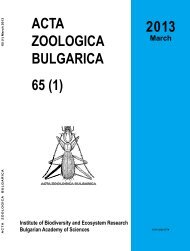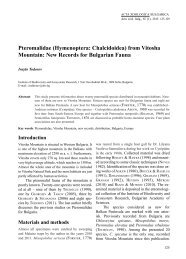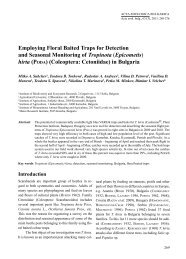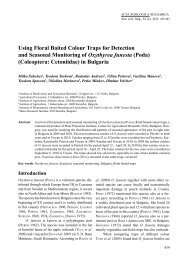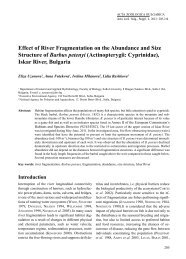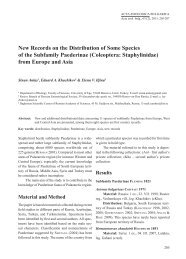First Record of Entomopoxvirus of Ips typographus - Acta zoologica ...
First Record of Entomopoxvirus of Ips typographus - Acta zoologica ...
First Record of Entomopoxvirus of Ips typographus - Acta zoologica ...
You also want an ePaper? Increase the reach of your titles
YUMPU automatically turns print PDFs into web optimized ePapers that Google loves.
Yaman M., H. Baki 1,<br />
TAKOV et al. 2007, BURJANADZE, GOGINASHVILI 2009).<br />
According to the results mentioned above the<br />
infection rates were higher in Turkey, Germany and<br />
Bulgaria, but lower in Georgia and Austria. Georgia,<br />
Turkey and Bulgaria are neighbor countries but the<br />
reported infection rates <strong>of</strong> ItEPV were different. To<br />
explain these differences more extensive studies are<br />
needed in this area.<br />
Till now, there is no any virus record from I.<br />
<strong>typographus</strong> in Turkey although Asia is a potential<br />
source <strong>of</strong> new and interesting virus strains (MURILLO<br />
et al. 2001). ItEPV presented here is the fi rst pathogen<br />
<strong>of</strong> I. <strong>typographus</strong> for Turkey and could be an<br />
References<br />
BURJANADZE M., N. GOGINASHVILI 2009. Occurrence <strong>of</strong> Pathogens<br />
and Nematodes in the Spruce Bark Beetles, <strong>Ips</strong> <strong>typographus</strong><br />
(Coleoptera: Scolytidae) in Borjomi Gorge. – Bulletin <strong>of</strong> the<br />
Georgian National Academy <strong>of</strong> Sciences, 3 (1):145-150.<br />
EROĞLU M., H. ALKAN-AKINCI, G. E. ÖZCAN 2005. Kabuk böceği<br />
salgınlarının nedenleri ve boyutları. – Orman ve Av, 82<br />
(5): 27–34.<br />
HÄNDEL U., R. WEGENSTEINER, J. WEISER, Z. ZIZKA 2003. Occurrence<br />
<strong>of</strong> pathogens in associated living bark beetles (Col.,<br />
Scolytidae) from different spruce stands in Austria. – Journal<br />
<strong>of</strong> Pest Sciences, 76: 22-32.<br />
KARNOVSKY M. J. 1971. Use <strong>of</strong> ferrocyanide-reduced osmium<br />
tetroxide in electron microscopy. In: Proc. 14th Ann. Meet.<br />
Am. Soc. Cell Biol. p. 146.<br />
MURILLO R., D. MUNOZ, J.J. LIPA, P. CABALLERO 2001. Biochemical<br />
characterization <strong>of</strong> three nucleopolyhedrovirus isolates <strong>of</strong><br />
Spodoptera exigua and Mamestra brassicae. – Journal <strong>of</strong><br />
Applied Entomology, 125: 267-270.<br />
MYERS J. H. 1988. Can a general hypothesis explain population<br />
cycles <strong>of</strong> forest Lepidoptera. – Advances in Ecological<br />
Research, 18: 179-242.<br />
REYNOLDS E. S. 1963. The use <strong>of</strong> lead citrate at high pH as an<br />
electronopaque stain in electron microscopy. – Journal <strong>of</strong><br />
Cell Biology, 17: 208–212.<br />
SPURR A. R. 1969. A low-viscosity epoxy resin embedding medium<br />
for electron microscopy. – Clinical Microbiology<br />
Research, 3: 197–218.<br />
TAKOV D., D. PILARSKA, R. WEGENSTEINER 2006. Entomopathogens<br />
in <strong>Ips</strong> <strong>typographus</strong> (Coleoptera:Scolytidae) from Several<br />
Spruce Stands in Bulgaria. – <strong>Acta</strong> Zoologica Bulgarıca,<br />
58 (3): 409-420.<br />
TAKOV D, D. DOYCHEV, R. WEGENSTEINER, D. PILARSKA 2007.<br />
Study <strong>of</strong> Bark Beetle (Coleoptera, Scolytidae) Pathogens<br />
from Coniferous stands in Bulgaria. – <strong>Acta</strong> Zoologica<br />
Bulgarıca, 59 (10): 87-96.<br />
TONKA T., J. WEISER, O. PULTAR 2009. <strong>Entomopoxvirus</strong> in the<br />
spruce bark beetle, <strong>Ips</strong> typograhus and its laboratory<br />
management. IUFRO WG 7.03.10 Methodology <strong>of</strong> Forest<br />
Insect and Disease Survey in Central Europe September 15<br />
to 19. Strbske Pleso, Slovakia, 63.<br />
202<br />
alternative biological control agent <strong>of</strong> this insect, because<br />
EPV gives very promising results in biological<br />
control <strong>of</strong> insects. Recently, TONKA et al. (2009)<br />
accomplished to test the laboratory management <strong>of</strong><br />
entomopoxvirus in <strong>Ips</strong> typograhus. They found that<br />
595 <strong>of</strong> the tested 1142 beetles were infected by the<br />
entomopoxvirus. The authors were able to keep this<br />
virus in the laboratory for several weeks.<br />
Acknowledgments: This study was supported by The Research<br />
Foundation <strong>of</strong> Karadeniz Technical University (Project<br />
No 2007.111.004.4). The authors wish to express their thanks to<br />
Pr<strong>of</strong>. Dr. Klaus Hausmann and Dr. Renate Radek for making this<br />
study possible (Institute <strong>of</strong> Biology/Zoology, Free University <strong>of</strong><br />
Berlin, Königin-Luise-Str. 1-3, 14195 Berlin, Germany).<br />
TOPER KAYGIN A. 2007. Endüstriyel odun zararlıları. Nobel<br />
Yayınları. Ankara.<br />
WEGENSTEINER R. 2004. Pathogens in bark beetles. – In: Lieutier<br />
F., Day K. R., Battisti A., Gregoire J. C., Evans H. F. (Eds.):<br />
Bark and wood boring insects in living trees in Europe, a<br />
synthesis. Kluwer, Dordrecht, 291-313.<br />
WEGENSTEINER R., J. WEISER 1995. A new entomopoxvirus in the<br />
bark beetle <strong>Ips</strong> <strong>typographus</strong> (Coleoptera, Scolytidae). –<br />
Journal <strong>of</strong> Invertebrate Pathology, 65: 203-205.<br />
WEGENSTEINER R., J. WEISER 1996. Untersuchungen zum Auftreten<br />
von Pathogenen bei <strong>Ips</strong> <strong>typographus</strong> (Col., Scol.) aus einem<br />
Naturschutzgebiet im Schwarzwald (Baden Württenberg)<br />
(in German). – Anzeiger für. Schädlingkunde, Pfl anzenschutz,<br />
Umweltschutz, 69: 162-167.<br />
WEGENSTEINER R., J. WEISER, E. FÜHRER 1996. Observations on the<br />
occurrence <strong>of</strong> pathogens in the bark beetle <strong>Ips</strong> <strong>typographus</strong><br />
L. (Coleoptera. Scolytidae). – Journal <strong>of</strong> Applied Entomology,<br />
120: 199-204.<br />
WEISER J., R. WEGENSTEINER, Z. ZIZKA 1998. Unikaryon montanum<br />
sp.n. (Protista: Microspora), a new pathogen <strong>of</strong> the spruce<br />
bark beetle <strong>Ips</strong> <strong>typographus</strong> (Coleoptera: Scolytidae). –<br />
Folia Parasitologica, 45: 191-195.<br />
WEISER J., J. HOLUSA, Z. ZIZKA 2006. Larssoniella duplicati<br />
n.sp. (Microsporidia. Unikaryonidae), a newly described<br />
pathogen infecting the double-spined spruce bark beetle, <strong>Ips</strong><br />
duplicatus (Coleoptera, Scolytidae) in the Czech Republic.<br />
– Journal <strong>of</strong> Pest Science, 79: 127-135.<br />
YAMAN M., R. RADEK 2005. Helicosporidium infection <strong>of</strong> the<br />
great Europen spruce bark beetle, Dendroctonus micans<br />
(Coleoptera. Scolytidae). – European Journal <strong>of</strong> Protistology,<br />
41: 203-207.<br />
YAMAN M. 2007. Gregarina typographi Fuchs, a Gregarine Pathogen<br />
<strong>of</strong> the Six-Toothed Pine Bark Beetle, <strong>Ips</strong> sexdentatus<br />
(Boerner) (Coleoptera: Curculionidae, Scolytinae) in Turkey.<br />
-Turkish Journal <strong>of</strong> Zoology, 31: 359-363.<br />
YAMAN M., R. RADEK 2008. Identification, distribution and<br />
occurence <strong>of</strong> the ascomycete fungus Metschnikowia typographi<br />
in the great spruce bark beetle, Dendroctonus<br />
micans. – Folia Microbiologica, 53: 427-432.<br />
Received: 12.02.2011<br />
Accepted: 11.03.2011



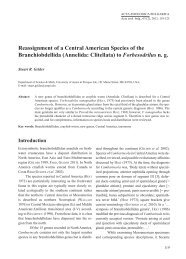
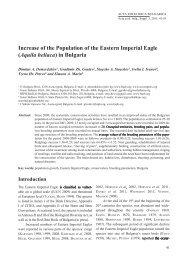
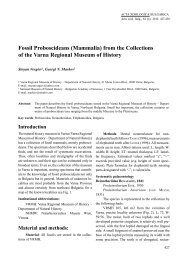
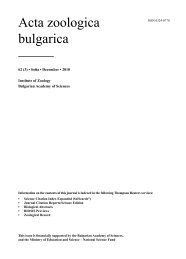
![table of contents [PDF] - Acta zoologica bulgarica](https://img.yumpu.com/52655254/1/186x260/table-of-contents-pdf-acta-zoologica-bulgarica.jpg?quality=85)
![table of contents [PDF] - Acta zoologica bulgarica](https://img.yumpu.com/52655255/1/186x260/table-of-contents-pdf-acta-zoologica-bulgarica.jpg?quality=85)
